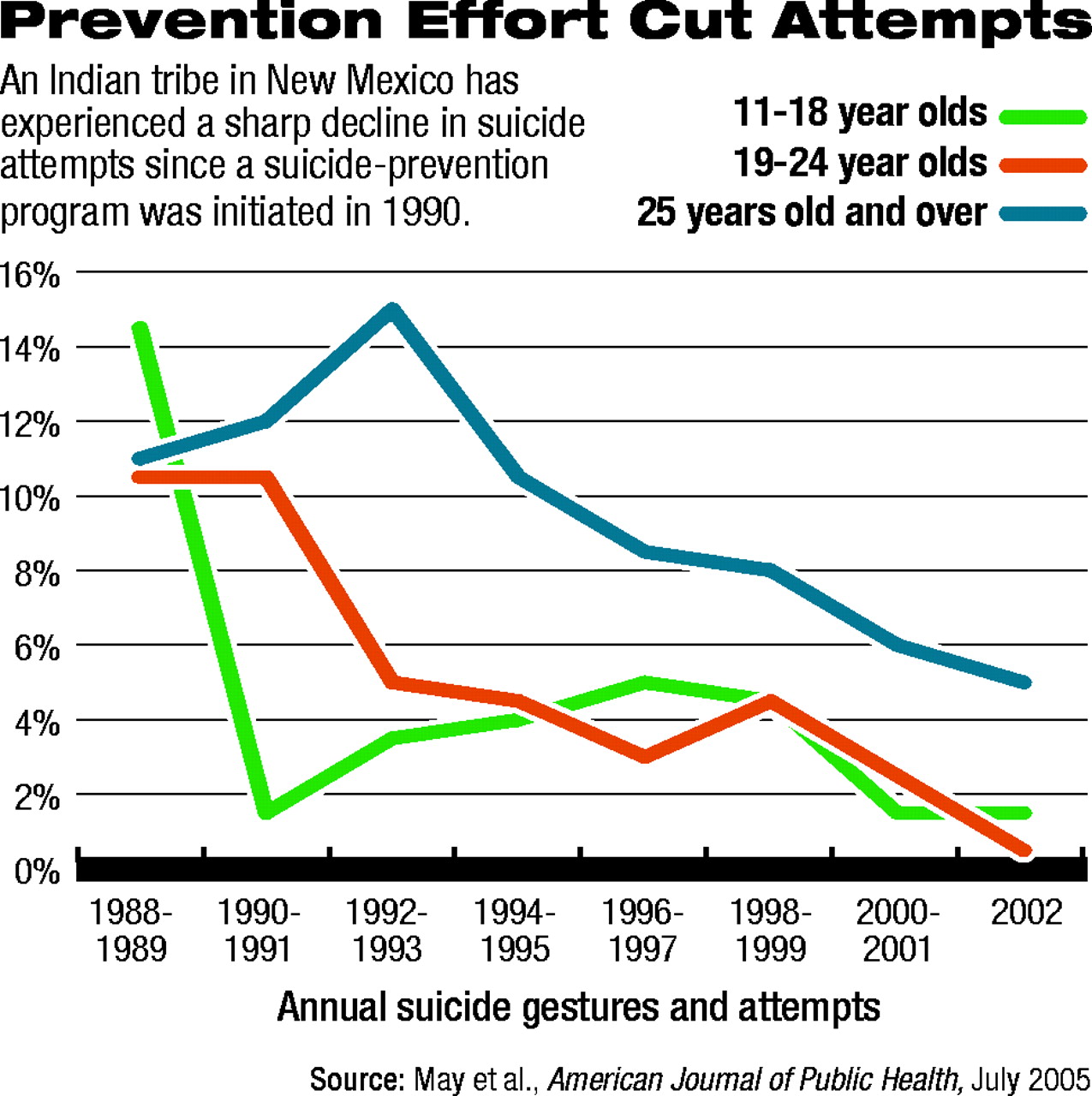In 1988 an Indian tribe located in the back country of New Mexico experienced annual rates of suicide and of suicide attempts that were 15 times higher than for the rest of the United States. The rates were five times higher than for other New Mexico Indian tribes, and suicidal activity was increasing among the tribe's youth.
So in 1990, the tribal council, with the aid of the U.S. Indian Health Service, launched a suicide prevention program directed toward its adolescents. Five years later, 20- to-24-year-olds were targeted as well.
The goals of the program included identifying suicide risk factors specific to the tribe, focusing on specific individuals or families at high suicide risk, providing such individuals and families with mental health services, and confronting suicide-related issues such as alcoholism, domestic violence, unemployment, and so forth. By 2002, the program had a staff of 57. Today, its annual budget is about $1 million.
Researchers have conducted a study to determine whether the program has reduced suicidal behaviors among members of this tribe, which, to protect the tribe's privacy, they refer to as the Western Athabaskan Tribal Nation. It appears that it has, the investigators reported in the July American Journal of Public Health.
The lead researcher was Philip May, Ph.D., a professor of family and community medicine at the University of New Mexico.
May and his colleagues gathered data documenting the tribe's annual number of suicide attempts and completed suicides two years before the suicide prevention program began—that is, in 1988—as well as after it started, with the last follow-up conducted in 2002. The group then analyzed the data to determine whether there were any changes in the number of suicide attempts or suicides during these years.
There were 20 suicide attempts a year on average before the program got underway in 1990, the researchers found. This average dropped to nine by the program's second year and then to four by 2002.
Moreover, the group aged 19 to 24 experienced the greatest decline in suicide attempts. The annual frequency of 11 attempts before the program got under way remained unchanged during the first two years after the program was launched, but subsequently declined to three in 2000 and one in 2002.
Youth aged 11 to 18 experienced a significant drop in suicide attempts as well. The annual frequency of attempts before the program began was 15. It decreased to two by the second year of the program, rose briefly to five in 1996, but returned to two during the period 2000 to 2002.
In contrast to the suicide-attempt findings, the annual frequency of completed suicides did not fall during the years of the study. The number of suicides for the tribe was one or two a year before the suicide prevention program was launched, and it remained the same even by the 2002 follow-up.
The suicide prevention program can probably be credited with the decline in suicide attempts that occurred during the period of the study, May and his colleagues concluded, especially since the dip occurred among tribal members under age 25—the age group primarily targeted by the program.
Concomitantly, it may be that the program was unsuccessful in reducing suicides per se during the years of the study, May and his team acknowledged. Because most suicides among New Mexico Indians have historically occurred among tribal members younger than age 35 years, have frequently involved alcohol, have been instigated by firearms or hanging, and have been characterized as impulsive, they said, “one would expect suicide completions to be more resistant to programmatic intervention and prevention than gestures and attempts.”
Nonetheless, they pointed out, it could be that the suicide prevention program is halting suicides to some degree since “no increase in suicide completions occurred on the reservation during the period of the program” and since “there is some evidence that suicide completions may have decreased for the target population, although the numbers are too small for statistical inference.”
May told Psychiatric News that other tribal communities and Indian Health Service officials have contacted him and his coauthors for more details about the program so that they can try to replicate it.
The study was funded by the U.S. Indian Health Service, Centers for Disease Control and Prevention, and the Indian tribe that implemented the suicide prevention program.
An abstract of “Outcome Evaluation of a Public Health Approach to Suicide Prevention in an American Indian Tribal Nation” is posted at<www.ajph.org/cgi/content/abstract/95/7/1238>.▪
Am J Health Syst Pharm 2005 95 1238

